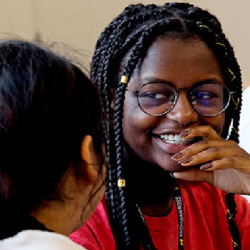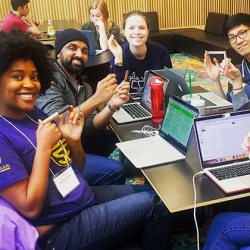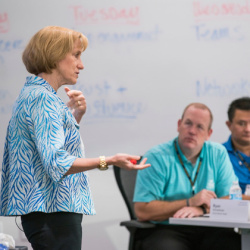Strategy and Past Experience Helped this Team Stay Focused to Win the Crisis Challenge

By: Nicole Crosby, MBA ’20 and Brad Lorant, OMBA ’22
This blog was written about an event that took place in February 2020, before the widespread outbreak of COVID-19 in the U.S.
Members of Team D9 Industries, Winners of Crisis Challenge: Justin Woods, MSW ’21; Elise Gordon, MBA ’21; Nicole Crosby, MBA ’20; Jacqueline Salamack, MBA ’20; Allie Gluck, MBA ’20; Brad Lorant, MBA ’22; Brad Kohlmeyer, MBA ’22
On a (less than typical) Thursday night, we walked into the Blau Colloquium at the Ross School of Business. We found a row of chairs that matched the number we were handed at check-in to meet a group of individuals we would spend the next 24 hours with — facing what felt like a very real corporate crisis.
The Leadership Crisis Challenge, organized by the Sanger Leadership Center, provided our team with an excellent opportunity to step outside of our daily comfort zones, and challenge ourselves in a stressful but low-stakes environment where it was safe to take on new roles because the consequence of failure was (admittedly) much lower than it felt.
As the co-founders (CEO and CINO), we worked with the rest of our team to align an approach to manage our simulated crisis: Our autonomous rideshare vehicle collided with a bicyclist on the fleet’s launch day.
We knew almost instantly, and viscerally, as a team that safety needed to be our company’s top priority. However, one of the most critical, but less anticipated, pieces of managing this crisis was deciding how to both implement and communicate that decision to a variety of stakeholders.
Our team was lucky to have members with diverse prior work experiences, and our ability to draw on these experiences allowed us to create an action plan that addressed the needs of all our stakeholders, ultimately leading to our success. While working through the crisis, we took turns playing devil’s advocate in order to think about the situation from different perspectives.
The Crisis Challenge had three phases: an immediate public statement; a board meeting; and a public press conference. Although we kept the key message consistent, we handled each very differently.
Our public statement explained the incident and the immediate actions we took to avoid additional accidents. Our board meeting was focused on the future of the company. We explained the decisions our artificial intelligence made and showed our technology was not broken; our CFO brought clear analysis that supported a healthy future, and our CMO and CHRO laid out a plan for rebuilding trust with the public and within the company. Our press conference was led by our CCO, and in it our team withheld many of the details we knew, focusing on a clear and concise message that always came back to public safety and took a holistic view of the industry. We conveyed our plan for rebuilding public trust in the company and communicated our path to returning to operations. We emphasized safety as our top priority and explained how our technology would end up saving hundreds of thousands of lives in the future.
The Crisis Challenge certainly challenged us, but it also brought us close as a team.
We approached it with an eagerness to learn from the prompts and from one another. Throughout the two days, we stuck together as a team… including during a much-appreciated lunchtime break on the football field (our press conference was much better than our field goal attempts). As much as it was a challenge, it was also a blast!







